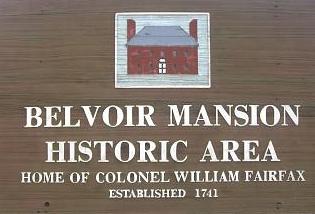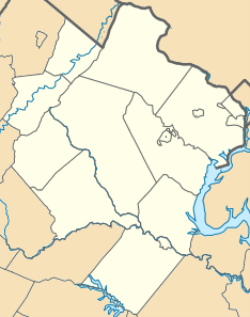Belvoir (plantation) facts for kids
|
Belvoir Mansion Ruins and the Fairfax Grave
|
|

Historic site located at Fort Belvoir
|
|
| Location | SE of intersection of 23rd St. and Belvoir Rd., parking lot on eastern side of Forney Loop Fort Belvoir, Virginia |
|---|---|
| Built | 1736 |
| NRHP reference No. | 73002337 |
Quick facts for kids Significant dates |
|
| Added to NRHP | June 04, 1973 |
Belvoir was a large estate and farm in colonial Virginia. It belonged to the important Fairfax family. The estate was built and run using the forced labor of enslaved people. It was located on the west bank of the Potomac River in Fairfax County, Virginia. Today, this area is part of Fort Belvoir. The main house, known as Belvoir Manor or Belvoir Mansion, was destroyed by fire in 1783. It was further damaged during the War of 1812. The site is now listed on the National Register of Historic Places as "Belvoir Mansion Ruins and the Fairfax Grave."
Contents
Belvoir's Story
Early Days
How Belvoir Started
In 1669, a man named William Green received a large piece of land. This land was about 1,150 acres (4.7 km2) big. It was located between Dogue Creek and Accotink Creek, along the Potomac River.
Later, in the early 1700s, this land was divided and sold. But in the 1730s, it was put back together. This created the main part of Colonel William Fairfax's large farm, Belvoir Manor. His farm eventually grew to about 2,200 acres (8.9 km2).
Building the Mansion
Fairfax's beautiful new home was finished in 1741. Old papers and items found at Belvoir Manor show how fancy the Fairfax family lived. This lifestyle was possible because they used the forced labor of enslaved people.
The mansion was described as large and well-furnished in 1774. It had "tables, chairs, and every other necessary article...very elegant." The family bought dishes from Europe and Asia for their meals.
People like William Fairfax were a small group of wealthy landowners in Fairfax County. Most of their neighbors were smaller farmers. The wealth of these landowners came from their land and the number of people they enslaved. These enslaved people were treated as property. They likely used the plain dishes found in the smaller buildings at Belvoir Manor. After William Fairfax died in 1757, his oldest son, George William Fairfax (1729–87), took over the farm.
Important Visitors
Thomas Fairfax, 6th Lord Fairfax of Cameron, came to Virginia between 1735 and 1737. He wanted to check on his family's lands. Lord Fairfax came to Belvoir to help manage his family's estates. These lands were in Virginia's Northern Neck area. They were inherited from his mother.
Fairfax's sister, Anne, married Lawrence Washington in 1743. A young George Washington, Lawrence's half-brother, often visited Belvoir. Lawrence wanted to help George succeed. So, he introduced George to George William Fairfax. The two men became good friends, even though George William was seven years older. A close friendship also grew between Sally Fairfax and Washington. Washington also became friends with Bryan Fairfax, George William's younger half-brother.
In 1752, Lord Fairfax moved to Greenway Court. This was closer to his undeveloped land. He hired George Washington to survey some land at Belvoir.
Belvoir Left Empty
When Fairfax left Belvoir for England in 1773, he rented the estate. Its furniture was sold in 1774. During the American Revolutionary War, Virginia took control of the property. In 1783, the mansion and some other buildings burned down. The farm slowly fell into ruins. Ferdinando Fairfax, who inherited the property, did not live there. Stone was taken from the bluffs below the old mansion. But the house site itself was not rebuilt.
19th Century Changes
Belvoir Plantation was damaged even more during the War of 1812. In August 1814, British forces attacked and burned Washington, D.C. A British navy group then sailed up the Potomac River. They forced the city of Alexandria to surrender. The fleet then started its 180-mile (290 km) trip back down the river.
On September 1, the British tried to pass a deep part of the river near Belvoir. This spot was known as a good place to defend the river. A group of American soldiers quickly set up cannons on the bluff above the river. For four days, British and American forces fired at each other. The British fleet eventually passed the American positions. But British shells destroyed what little was left of the old Belvoir Manor.
The Fairfax family's connection to Belvoir Plantation ended when Ferdinando Fairfax died in 1820. Over the next ten years, William Herbert bought the property. He used it as a guarantee for a loan. In the 1830s, Thomas Irwin, who had loaned Herbert money, ran the shad fisheries at White House Point. Herbert could not pay his debts. This led to Belvoir being sold at a public sale in 1838.
All the big 18th-century farms in the Belvoir area changed a lot before the American Civil War. The land became less fertile. Also, land was divided among family members. As new landowners moved into southeastern Fairfax County, how land was used and owned changed.
20th Century and Today
In 1917, the Belvoir property was brought together. It was given to the U.S. Army by Virginia. This land eventually became the modern military base known as Fort Belvoir.
The Belvoir ruins are listed on the National Register of Historic Places (since 1973). However, you cannot easily visit them. This is because they are located on an active military base.





